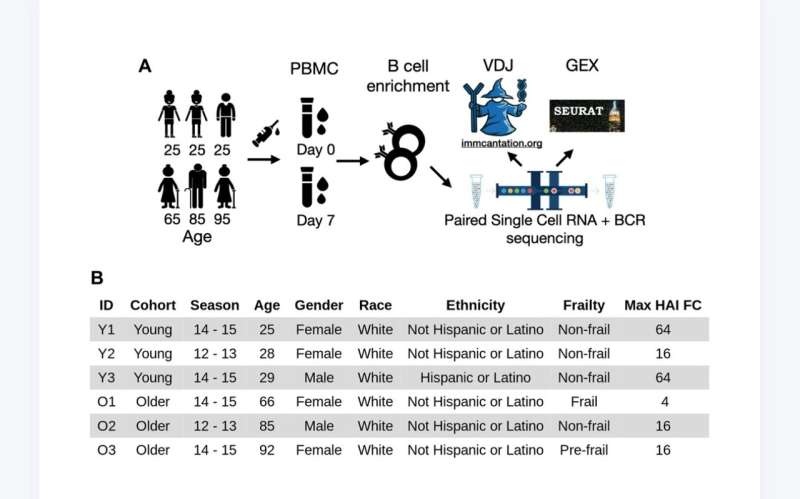This article has been reviewed according to Science X's editorial process and policies. Editors have highlighted the following attributes while ensuring the content's credibility:
fact-checked
proofread
B cell response after influenza vaccine in young and older adults

A new research paper was published in Aging, titled "High-throughput single-cell profiling of B cell responses following inactivated influenza vaccination in young and older adults."
Seasonal influenza contributes to a substantial disease burden, resulting in approximately 10 million hospital visits and 50 thousand deaths in a typical year in the United States. 70–85% of the mortality occurs in people over the age of 65. Influenza vaccination is the best protection against the virus, but it is less effective for the elderly, which may be in part due to differences in the quantity or type of B cells induced by vaccination.
In their new study, researchers Meng Wang, Ruoyi Jiang, Subhasis Mohanty, Hailong Meng, Albert C. Shaw, and Steven H. Kleinstein from Yale University / Yale School of Medicine investigated this possibility.
"[...] we sorted pre- and post-vaccination peripheral blood B cells from three young and three older adults with strong antibody responses to the inactivated influenza vaccine and employed single-cell technology to simultaneously profile the gene expression and the B cell receptor (BCR) of the B cells," write the researchers.
Prior to vaccination, the researchers observed a higher somatic hypermutation frequency and a higher abundance of activated B cells in older adults than in young adults. Following vaccination, young adults mounted a more clonal response than older adults.
The expanded clones included a mix of plasmablasts, activated B cells, and resting memory B cells in both age groups, with a decreased proportion of plasmablasts in older adults. Differential abundance analysis identified additional vaccine-responsive cells that were not part of expanded clones, especially in older adults.
"To summarize, we showed a quantitative difference in B cell response following vaccination between age groups, with expansion dominated by plasmablasts in the young, and activated B cells in older adults. [...] Overall, this study provides insights into the B cell vaccine response differences between young and older adults and may be beneficial to design more effective vaccines in the older age groups," the researchers write.
More information: Meng Wang et al, High-throughput single-cell profiling of B cell responses following inactivated influenza vaccination in young and older adults, Aging (2023). DOI: 10.18632/aging.204778




















